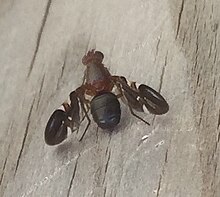Source: Wikipedia
| Delphinia picta | |
|---|---|

| |
| Scientific classification | |
| Domain: | Eukaryota |
| Kingdom: | Animalia |
| Phylum: | Arthropoda |
| Class: | Insecta |
| Order: | Diptera |
| Family: | Ulidiidae |
| Subfamily: | Otitinae |
| Tribe: | Cephaliini |
| Genus: | Delphinia Robineau-Desvoidy, 1830[2] |
| Species: | D. picta
|
| Binomial name | |
| Delphinia picta | |
| Synonyms[1][5] | |
| |
Delphinia picta is a species of picture-winged fly in the family Ulidiidae. The specific name picta is from Latin and means "painted."[6] It is the only species in the monospecific genus Delphinia. It is found in the United States on the East Coast and in the Midwest from Florida to Maine across to Kansas through Minnesota[5][1][4] but also can be found in Mexico[7] and El Salvador.[8] It is sometimes mistaken for a species of fruit fly, but D. picta do not feed on living plant matter, as they are detritivores and eat decaying plant matter.[5][4][9] They also have been observed eating fermenting frass from Megacyllene robiniae on black locust trees.[10] They can be found almost anywhere there is decaying vegetation: landfills, temperate deciduous forests, swamps, and even shaded fields.[9]
Description[edit]
The best way to identify the species is by the distinct pattern on its wings, which are shiny and dark brown with a hyaline background.[4] Its body is about 7mm long with a black abdomen and a light brown head, thorax, and legs.[4] The ovipositor averages 1.27mm long with two dorsal and one ventral prominent pairs of setae, as well as many short setae on both sides.[4] The tip of the ovipositor also has a slight bend downward.[4]
Life cycle[edit]
Adults raised in the lab usually live less than 40 days, but can live up to 69 days.[9] Mating takes place in the evening two days after emergence from pupae.[9] The female will wave her wings gently and a male will respond by flicking his wings before copulation.[9] Courtship may also include one or more of the partners blowing a bubble from their mouth.[9] Females will lay up to 500 eggs in decaying herbaceous plant matter, which then hatch into larvae in 4 to 6 days.[9] Larvae develop through three instar stages and reach pupae in 21–30 days then finish pupating 14–17 days later.[9] The development is affected by the amount of daylight: D. picta is a multivoltine species with one generation going from May to July and the other overwintering as mature larvae.[9]
Ecology[edit]
Among the plants it associates with are black locust (Robinia pseudoacacia), eastern cottonwood (Populus deltoides),[10] and saw palmetto (Serenoa repens).[11] It is prey for wasps, such as Crabro monticola.[12]
Gallery[edit]

References[edit]
- ^ a b c Bisby, F.A.; Roskov, Y.R., eds. (2011). "Delphinia picta". Catalogue of Life. Reading, UK. Archived from the original on 29 September 2017. Retrieved 15 August 2017.
- ^ Robineau-Desvoidy, André Jean Baptiste (1830). "Essai sur les myodaires". Mémoires presentés à l'Institut des Sciences, Lettres et Arts, par divers savants et lus dans ses assemblées: Sciences, Mathématiques et Physique. 2 (2): 1–813. Retrieved 15 July 2018.
- ^ Brimley, Clement Samuel; Wray, David Lonzo (1938). "Diptera". The insects of North Carolina, being a list of the insects of North Carolina and their close relatives. Raleigh, NC. p. 381. Retrieved 18 August 2017.
{{cite book}}: CS1 maint: location missing publisher (link) - ^ a b c d e f g Weems, Jr., H.V. (May 1970). "A Picture-winged Fly, Delphinia Picta (Fabricius) (Diptera: Otitidae)" (PDF). Division of Plant Industry, Entomology Section. Entomology Circular. No. 96. Gainesville, FL: Florida Department of Agriculture and Consumer Services. p. 2. Archived (PDF) from the original on 19 October 2015. Retrieved 15 August 2017.
- ^ a b c Stone, Alan; Sabrosky, Curtis W.; Wirth, Willis W.; Foote, Richard H.; Coulson, Jack R.; Steyskal, George C. (August 1965). "Superfamily Tephritoidea" (PDF). A Catalog of the Diptera of America North of Mexico. USDA agriculture handbooks. Vol. 276. Washington, DC: Agricultural Research Service, U.S. Department of Agriculture (published 1965). pp. 642, 644. ISSN 0065-4612. OCLC 1573294. Retrieved 16 August 2017.[permanent dead link]
- ^ Borror, Donald J. (1960). Dictionary of Word Roots and Combining Forms. Mayfield Publishing Company. ISBN 9780874840537. OCLC 650233514.
- ^ "Delphinia picta · iNaturalist.org". iNaturalist.org. California Academy of Sciences. 15 August 2017. Archived from the original on 22 August 2017. Retrieved 18 August 2017.
- ^ Steyskal, George C. (17 December 1971). Marsh, Paul M. (ed.). "Delphinia picta (Fabricius) in Central America-(Diptera-Otitidea)" (PDF). Proceedings of the Entomological Society of Washington. 73 (4): 445. ISSN 0013-8797. LCCN 08018808. OCLC 1568029. Archived from the original on 22 August 2017. Retrieved 17 August 2017.
- ^ a b c d e f g h i Allen, E. J.; Foote, B. A. (17 July 1967). "Biology and Immature Stages of Three Species of Otitidae (Diptera) Which Have Saprophagous Larvae" (PDF). Annals of the Entomological Society of America. 60 (4): 826–836. doi:10.1093/aesa/60.4.826. Retrieved 16 August 2017.
- ^ a b Steyskal, George C. (1949). "The Dipterous Fauna of Tree Trunks" (PDF). Papers of the Michigan Academy of Science, Arts and Letters. 35: 121–134. Archived (PDF) from the original on 15 May 2012. Retrieved 17 August 2017.
- ^ Deyrup, Mark; Deyrup, Leif (2012). "The Diversity of Insects Visiting Flowers of Saw Palmetto (Arecaceae)". Florida Entomologist. 95 (3) (published September 2012): 711–730. doi:10.1653/024.095.0322. ISSN 0015-4040. Archived from the original on 2018-05-20. Retrieved 2018-12-14.
- ^ Kurczewski, Frank E (2003). "Comparative Nesting Behavior of Crabro monticola (Hymenoptera:Sphecidae)". Northeastern Naturalist. 10 (4): 440. doi:10.1656/1092-6194(2003)010[0425:CNBOCM]2.0.CO;2. ISSN 1092-6194. S2CID 86012523.


